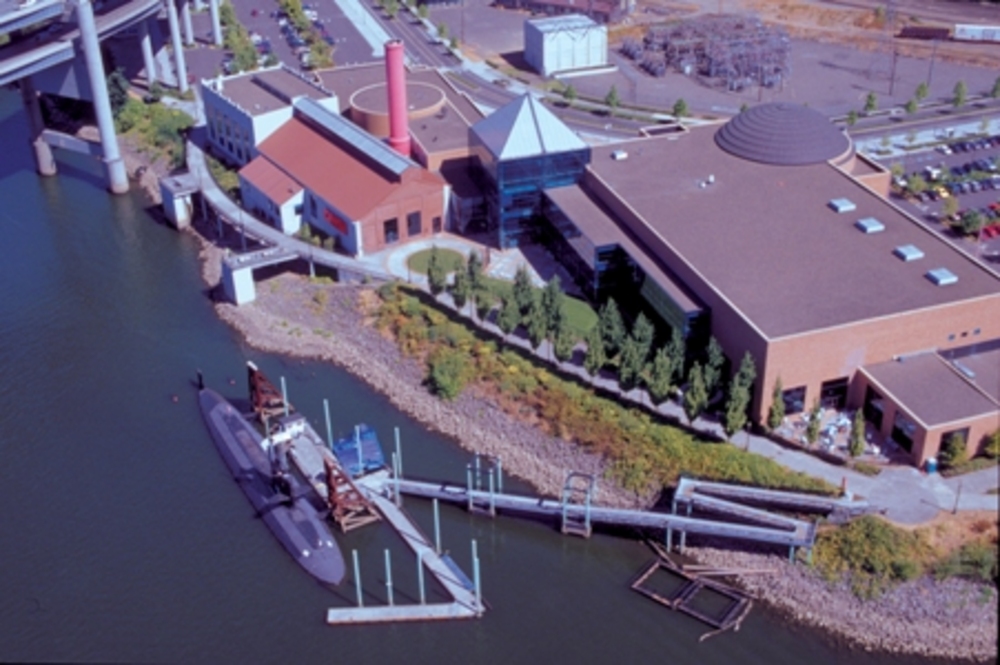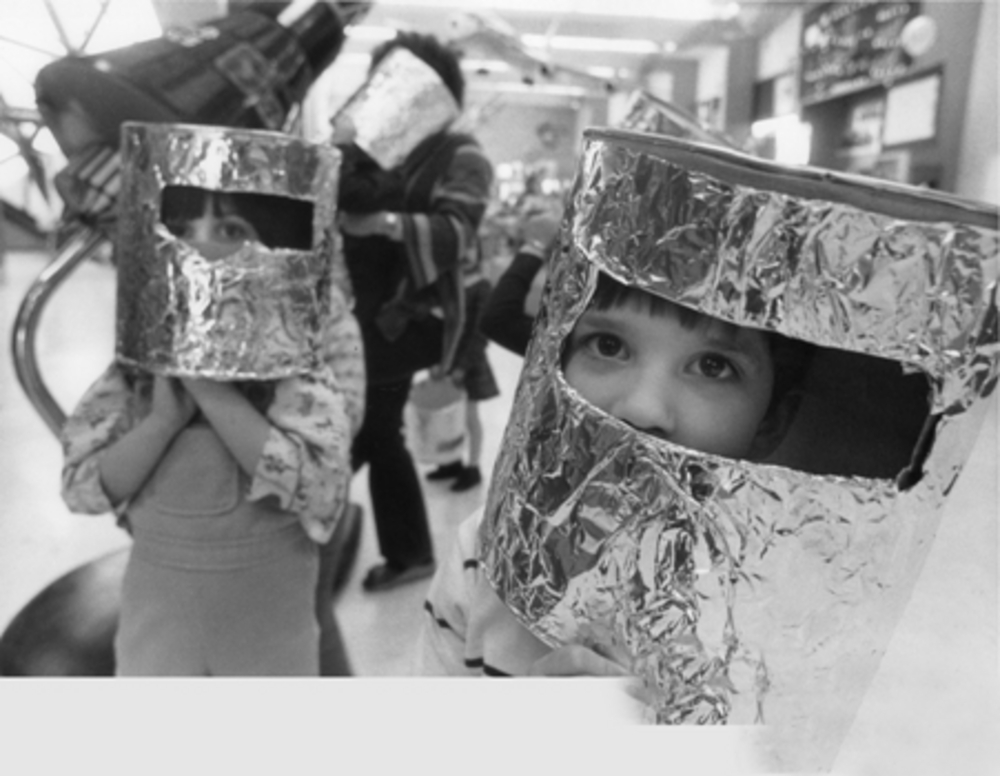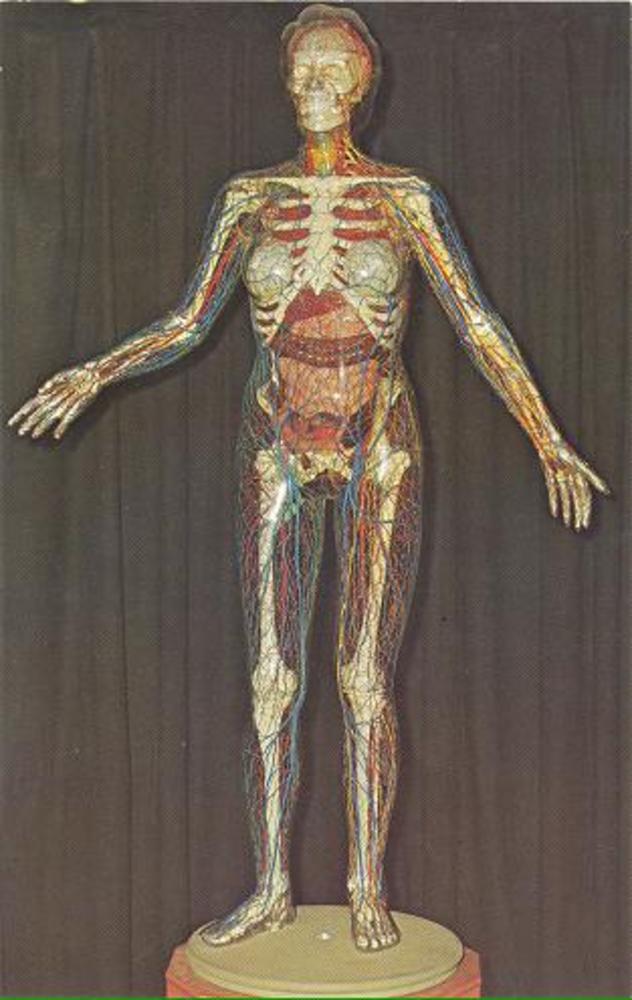The Oregon Museum of Science and Industry (OMSI) is Oregon's largest center of informal science education. Consisting of five exhibit halls, eight science labs, a planetarium, the Empirical Theater, and a retired U.S. Navy submarine open for tours, OMSI entertains and educates visitors through hands-on activities, interactive displays, science classes, outdoor camps, and by serving as a hub for local science clubs. From its humble beginnings to its current multi-million dollar facility on the east bank of the Willamette River across from downtown Portland, OMSI has grown into one of the ten largest science centers in the country.
In the beginning, OMSI was nothing more than a collection of odd artifacts scattered about in Portland's City Hall. Pioneer and park enthusiast Colonel L.L. Hawkins started the city museum in 1903, and for the next three decades, visitors toured the displays in City Hall's corridors and light wells, marveling at curiosities that included a stuffed black bear. When it was ordered to move in 1936, the museum's 12,000 artifacts were put into storage in basements and attics throughout the city.
Efforts to establish a permanent museum received a boost in 1943 when Oregon Governor Earl W. Snell appointed a "Committee of 100" to study the issue, which led to the formation of the Oregon Museum Foundation (OMF) on November 15, 1944, with Portland hydraulic engineer John C. Stevens as its first president. Headquartered in the "Writing Room" of the old Portland Hotel, the OMF solicited donations and memberships and displayed small exhibits around town to drum up interest. Stevens convinced developer Ralph B. Lloyd to donate space for a temporary museum, and the first Oregon Museum of Science and Industry opened its doors on May 17, 1949, in an old house at 908 N.E. Hassalo Street where stuffed animals, mounted birds, sea shells, phosphorescent minerals, American Indian artifacts, and some small live animals were displayed. A domed planetarium was erected on the front lawn in 1950—the first one in the Pacific Northwest. In 1957, the museum was once again ordered to move to make way for new development.
The City of Portland offered to lease the museum a piece of land at the edge of Washington Park for 99 years at $1 per year, but construction costs proved too expensive. The trustees turned to an old fashioned barn-raising. Harry M. Mason encouraged union bricklayers to donate labor, and other unions and businesses contributed labor and materials. On August 17, 1957, some 400 union bricklayers raised the museum walls in a single day. After Ernest and Fred Swigert donated $50,000 and ninety leading citizens guaranteed a $150,000 loan, the Oregon Museum of Science and Industry opened its new museum to the public on August 3, 1958. The star attraction was the $12,500 Transparent Lady exhibit.
OMSI's "push-button" natural history displays were gradually replaced with exhibits that offered direct visitor involvement, and science camps and fairs became increasingly popular. Lacking tax support, OMSI relied on fundraising to develop and expand its facilities. In 1967, the Spitz planetarium projector that had been in use since 1950 was replaced, and a last-minute donation by Harry C. Kendall enabled the museum to build a striking blue-green planetarium which opened that December. OMSI's popularity grew into the 1980s until the Washington Park building was stretched beyond its capacity. The land around the musuem was unstable, which made further expansion impossible. On December 3, 1986, OMSI announced that its new museum would be built on the east bank of the Willamette River on the site of the old Station L power plant donated by Portland General Electric (PGE). Ground-breaking occurred on July 9, 1990.
The "new OMSI" opened amid great fanfare on October 24, 1992. The $40 million, 210,000-square-foot museum was three times larger than the old building—the fifth largest science and industry museum in the U.S. It included a $6 million dollar OMNIMAX Dome Theater, an upgraded 210-seat planetarium, and more space for traveling exhibits. Despite overwhelming initial success, construction overruns left OMSI $33 million in debt, and by 1995 crushing interest payments and declining attendance threatened the museum with closure. Financial help from a consortium of local and state governments and a restructuring of its debt enabled OMSI to pay off a $4.9 million bank loan in 1998. Attendance improved, propelled by popular exhibits such as 2007's Star Wars: Where Science Meets Imagination, which drew 150,000 visitors, and Body Worlds 3, which drew over 350,000 visitors during its five-month run.
OMSI entertains and educates 1.1 million visitors annually with in-house and traveling exhibits and by building on its legacy of science classes, outdoor camps, and partnerships with schools, businesses, and science clubs. In 2013, OMSI replaced its IMAX theater with a four-story digital projection flat screen with 3D capability—the largest screen in Portland. Its educational outreach programs benefit students, teachers, and adults throughout the state—community service that earned OMSI the National Medal for Museum Service in 2007.
-
Kids play with Van de Graaff generator at OMSI..
Courtesy Oregon Museum of Science and Industry
-
Original OMSI building at 908 N.E. Hassalo Street, Portland.
Courtesy Oregon Museum of Science and Industry
-
![]()
Aerial view of OMSI facility.
Courtesy Oregon Museum of Science and Industry
-
![]()
U.S.S. Blueback submarine in Willamette River at OMSI.
Courtesy Oregon Museum of Science and Industry
-
![]()
OMSI plaza.
Courtesy Oregon Museum of Science and Industry
-
OMSI, kids in foil space helmets at OMSI.
Courtesy Oregon Museum of Science and Industry
-
![]()
Children doing chemistry at OMSI.
Courtesy Oregon Museum of Science and Industry
-
![]()
Visitor with Shab Levy's Gravitram at OMSI.
Courtesy Oregon Museum of Science and Industry
-
![]()
Talking Transparent Woman at OMSI.
Scanned image courtesy David Pelinka, original postcard photo by Ken Vermillion
Map This on the Oregon History WayFinder
The Oregon History Wayfinder is an interactive map that identifies significant places, people, and events in Oregon history.
Further Reading
ASTC, "Largest Science Centers in the United States," ASTC Research Reports, 2006
Huegli, Douglas P. "Museum Miracle in Oregon." Museum Notes, November 1959
OMSI history. https://omsi.edu/history-and-mission
Oberson, Viola. "One Man's Civic Dream Becomes Community's Push-Button Project," OMSI, 1963.









